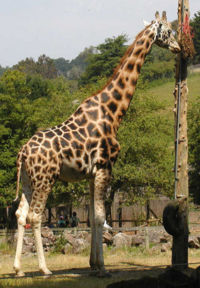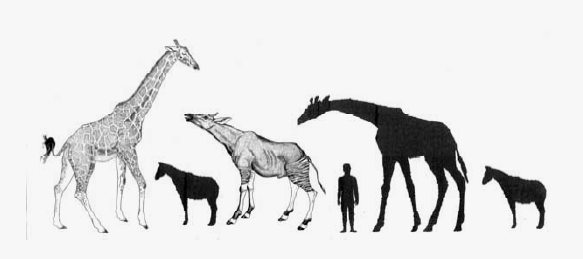Giraffe
 From Conservapedia
From Conservapedia | Giraffe | |
|---|---|

| |
| Giraffa camelopardalis rothchildi | |
| Scientific classification | |
| Kingdom Information | |
| Kingdom | Animalia |
| Phylum Information | |
| Phylum | Chordata |
| Sub-phylum | Vertebrata |
| Class Information | |
| Class | Mammalia |
| Order Information | |
| Order | Artiodactyla |
| Sub-order | Ruminantia |
| Infraorder | Pecora |
| Family Information | |
| Family | Giraffidae |
| Genus Information | |
| Genus | Giraffa |
| Species Information | |
| Species | G. camelopardalis |
| Population statistics | |
The giraffe is an ungulate (hoofed) mammal native to Africa. It is the tallest land animal and can grow up to 20 feet (6 m) in height. In spite of the extraordinary length of its neck, it has just seven vertebrae in its neck, just like other mammals. The coat is tan with brown patches, and the males use their bony horns and necks for fighting. Currently giraffes are considered to represent a single species classified into multiple subspecies, although in December 2007 a report in BioMed Central Biology claimed that there may be at least six species of giraffe in Africa.[1]
Contents
- 1 Subspecies
- 2 Distribution/Habitat
- 3 Diet
- 4 Behaviour
- 5 Reproduction
- 6 The giraffe's neck
- 7 References
Subspecies[edit]
- West African (G.c. peralta)
- Kordofan (G.c. antiquorum)
- Nubian (G.c. camelopardalis)
- Reticulated (G.c. reticulata)
- Rothschild (G.c. rothchildi)
- Masai (G.c. tippelskirchi)
- Thornicroft (G.c. thornicrofti)
- Southern African (G.c. capensis/G.c. angolensis).
Distribution/Habitat[edit]
Giraffes inhabit sub-Saharan African grassland with scattered trees. They are becoming increasingly rare in West Africa.
Diet[edit]
The giraffe feeds from tall trees, particularly Acacia and Commiphora. Their tongues grow up to 18 inches (45 cm) long, which helps them pick through the acacia tree’s spiky branches. Females bend their heads down over their meal, while males stretch up to reach the youngest shoots. To drink, giraffes have to lower their heads and spread their front legs wide apart to reach the ground.[2]
Behaviour[edit]
Giraffes form loosely constructed, scattered herds of up to 20 individuals, with large home range sizes, ranging from 3 square miles (5 km2) to 616 square miles (992 km2)[3] and constantly move from one group to another. Mature males often roam in search of breeding females, travelling up to 190 miles (300 km),[4] and fight for dominance using their necks and buttressed skulls. They have a life span of around 25 years. Giraffes only sleep for a few minutes at a time, and only sleep for a total of 30 minutes each day.
Reproduction[edit]
Sexual maturity is reached at age 4–5 years although bulls usually only mate at 8 or more years old. Gestation lasts 15 months, after which a single calf is born, although twins have been recorded very rarely. The female can mate again 5 months after giving birth, and there is no established breeding season. For the first few weeks the calf remains hidden in the shade with the mother returning to it, and later it joins a creche within the herd. Calves grow fast, and are weaned at 18 months, although they start eating solids well before then. Fifty per cent die in their first 6 months, the victims of predators.[5]
The giraffe's neck[edit]


Until recently, there were no fossil links that could demonstrate the gradual evolution of the long-necked giraffe from the short-necked giraffe. But Nikos Solounias of the New York Institute of Technology has described a transitional fossil from the late Miocene and early Pliocene. Its neck was a perfect intermediate between the short-neck ancestors and their long-neck descendants.[6] Some paleontologists postulate a "neck elongation macromutation" to explain the origin of the long-necked giraffe. Richard Dawkins also claims the origin of the long-necked giraffe is due to macromutation. Wolf-Ekkehard Lönnig points out: "This exception would naturally be fully unnecessary, if the gradual evolution of the long-necked giraffe could really be reconstructed through fossils, especially since he much prefers the gradualist view. Dawkins draws the okapi, in relation to the Giraffa, nearly twice as large as it really is. In this way, the problem of its evolution (the gap between the two forms) appears only half as large. One may well ask if this technique is useful in the search for truth."[7]
References[edit]
- ↑ Brown, David M. et al (2007) "Extensive population genetic structure in the giraffe" BMC Biology
- ↑ Amazing animals: Giraffe Science and nature: Animals BBC
- ↑ Brown, David M. op cit
- ↑ Brown, David M. op cit
- ↑ Wildfacts: Giraffe Science and Nature: Animals BBC
- ↑ http://www.newscientist.com/channel/life/mg19726451.700-evolution-what-missing-link.html Newscientist
- ↑ Lönnig, Wolf-Ekkehard "The Evolution of the Long-Necked Giraffe – What Do We Really Know?" (2006)
Categories: [Ruminants] [Evolution]
↧ Download as ZWI file | Last modified: 02/25/2023 08:30:48 | 8 views
☰ Source: https://www.conservapedia.com/Giraffe | License: CC BY-SA 3.0
 ZWI signed:
ZWI signed: KSF
KSF